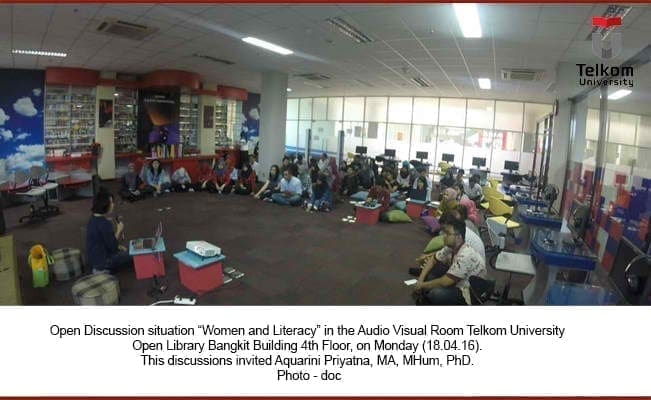BANDUNG, TEL-U – The Indonesian people, especially women, had just celebrated Kartini Day which annually celebrate on 21 April. But the fate of Indonesian women had not fully fortunate, especially in education. Keller Data (2015) mentions that the current population of the world reached 774 million illiterate people, where 493 million of whom are women. While in Indonesia, as many as 8.5 million people declared illiterate, and 64% of that amount, or about 5.4 million are women.
This was revealed in an open discussion on “Women and Literacy” in the Audio Visual Room Telkom University Open Library Bangkit Building 4th Floor, on Monday (18.04.16). This discussions invited Aquarini Priyatna, MA, MHum, PhD. According to Aquarini, literate and empowering women means improving the quality of community life. “Unfortunately, women still face discrimination in terms of literacy or education in Indonesia and the world,” she said.
According to Aquarini, literacy problem is not only related to the ability to write and read, but also about the knowledge base. This provision is very necessary for women so that they can give the maximum contribution to their community, and to avoid discriminatory attitudes in society.
“Based on research, the literacy issue other than with respect to gender issues, is also a matter of geography, social class, and economy. It can be seen from the number of Indonesian women were educated mostly in urban areas, have access to financial resources and infrastructure, “she said.
At the tertiary level, for example, only 6.62 percent of Indonesian women who successfully complete higher education. While men with a university degree the figure reached 7.21 percent. Of that number, 10.24 percent of woman with bachelor degree are in urban areas, while 2.90 percent are from the countryside.
In a study, Aquarini also found that the number of female applicants to higher education actually larger than the number of male applicants. Surprisingly, the number of women who have successfully completed it is smaller than male. The problem turned out to be lies in discrimination against women in the higher education process. “One of the simplest examples is the campus means that no pro on the condition of women get pregnant and breast-feeding. Because, a lot of the campus that does not provide a lift as well as nursing areas for female students, “he said.
“There is also discrimination in the campus culture. Call it when the election of BEM president, the female students is forbidden to run for the election. This behavior has hampered women’s organization which is networked ticket, so they missed the chance to develop themselves, and get access to be successful, “she said. (Purel / lib / raf)

